Here’s how to make a respectable sourdough loaf, in the least amount of time, using the least amount of steps, with the least amount of clean up. This guide is for the low-effort high-reward camp. Yes, you too can make and enjoy artisanal style sourdough without leaving your home or inordinate effort.
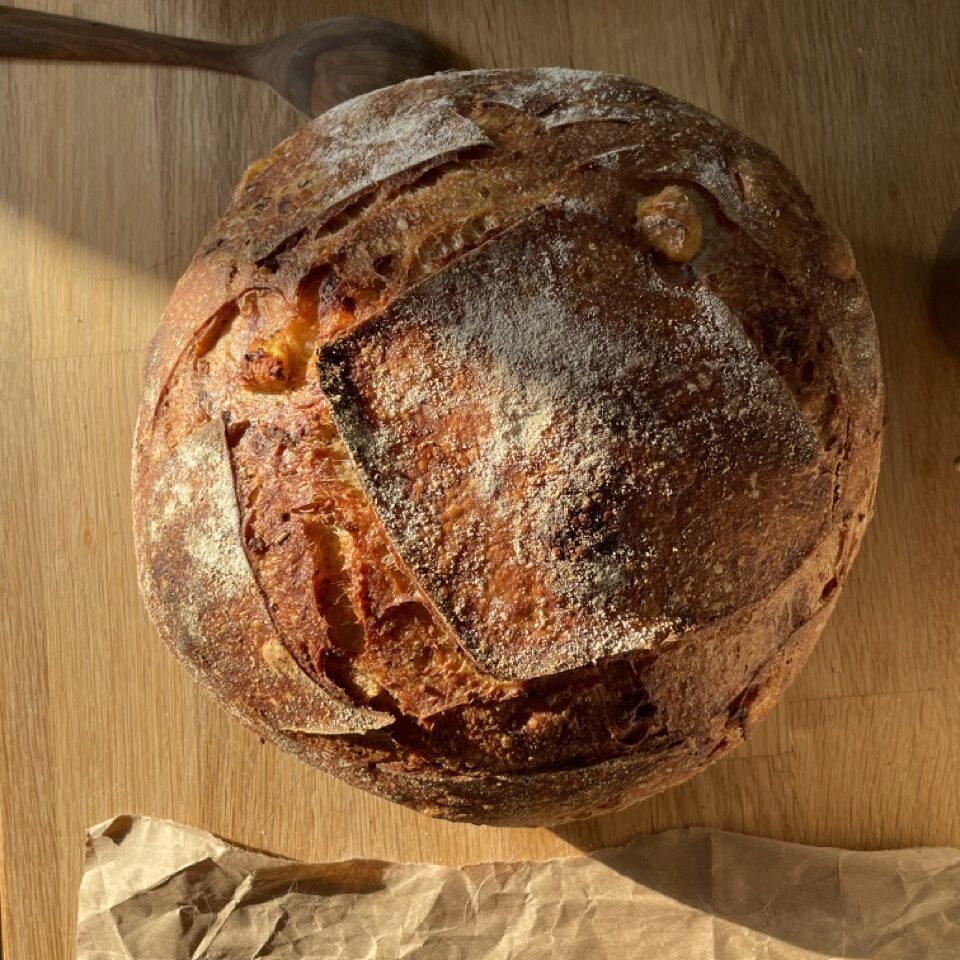
In Chinese there is a word 随便 (suíbiàn), roughly translated as casual, careless, or as one pleases. That is how I think home cooking should be like. Imagine throwing whatever you like into a big wok or pot, and sprinkling in whatever seasonings you feel like adding. Baking is another animal, and requires precise measurements and variables. When you bake bread for everyday eating, for sopping up soups and stews and for carrying avocados and olive oil, it is somewhere in the middle. Baking “everyday bread” requires a degree of accuracy, but that range is incredibly wide and allows for casual experimentation and shortcutting of methods. The key is understanding which corners you can cut and which you cannot.
(Note: this guide does not necessarily apply to other kinds of breads which require more care – e.g. enriched breads like brioche, shokupan, the notoriously difficult pannetone etc.)
Summary – how to cut corners baking everyday sourdough loaves
This list of shortcuts is for people who already have a basic understanding of how to bake sourdough. The rest of the post goes into more detail and explains more comprehensively how to make a sourdough loaf.
- You can eyeball how much to feed your starter when maintaining and readying it for use.
- Your starter can live in the fridge most of the time.
- You can skip the autolyse and mix everything (except add-ins) together in one step.
- You can skip preshaping.
- You can avoid cleaning the counter and shape the dough in your hands by doing a series of stretch/folds/coils before plopping into the banneton.
- You can bake directly in the dutch oven without transferring with parchment paper if your dutch oven is non-stick and has a flat bottom.
Equipment: what you need
You can still bake tasty sourdough even if you don’t have all the equipment below. The best advice I can give is to get started and see what happens.
Here are the tools that you need to make a respectable sourdough loaf along with tools that are highly recommended and optional:
- A kitchen scale is needed to measure the ingredients. Even with a flexible master recipe, measuring without a kitchen scale will lead to inconsistent results. This is the only equipment that you truly need for successful sourdough baking.
- Additionally, if your kitchen scale is not highly accurate, meaning that it can accurately read increments of 1 gram or less, I highly recommend using a small digital scale or a “microscale” for measuring salt. Measuring salt accurately is especially important because salt inhibits yeast and affects gluten development. High precision small scales that are accurate up to increments of 0.1 g or 0.01 g can be bought on Amazon or other marketplaces for less than 20 dollars. If you do not have a high precision scale for measuring small quantities and must make sourdough, err on the side of less salt if your starter is not very active because you do not feed your sourdough starter frequently or because it is a new starter.
- A dutch oven is highly recommended for getting a crusty loaf with good oven spring. While bread baked without a dutch oven can still be tasty, baking bread inside a dutch oven drastically improves the crust because the dutch oven traps steam and allows for baking at higher temperatures. Additionally, a dutch oven will allow more “oven spring” – that is, the expansion of the dough once it enters the hot oven. I recommend using a dutch oven without a knob so that the dutch oven can be inverted and the flat lid used as the bread tray. There are also specialized cast iron bread pans. However, they will be more expensive and not multi-functional.
- This is the dutch oven that I use. I like it because it is cast iron and naturally non-stick, meaning that I can bake directly in the dutch oven without parchment paper. The flat bottom/lid also makes scoring and handling/transferring the dough very easy. The size is perfect for boules (I do not know if it will fit batards).
- A banneton or proofing basket is highly recommended. Although not strictly necessary, a banneton or proofing basket will make bread baking a lot easier. I have successfully baked loaves without a banneton, proofing with round bowls lined with cheesecloth dusted with rice flour. However, a banneton not only makes proofing and transferring the dough to the hot oven easier, it also absorbs moisture from the skin of the dough, which allows for better scoring. Bannetons can be purchased on Amazon or other marketplaces for less than 20 dollars.
- A dough whisk is an optional tool which will make the initial mixing of the dough and its clean up fast. For years I baked bread without a dough whisk, using instead my hands, a sturdy wooden spoon, or a pair of chopsticks to mix the dough. Outside of a dough whisk, using hands is the most efficient way to mix dough, but a higher hydration dough will stick to your hands and be kind of a pain to wash off. If you do not have a dough whisk, chopsticks – especially a metal pair of chopsticks – are my preferred mixing tool due to ease of clean up.
- A bread lame for scoring the dough is optional, but will make scoring easier. A sharp knife or a razor blade can be used instead. One advantage of a bread lame is the slight curve of the blade which gives the bread its “ear”. Although an “ear” is said to be a hallmark of a well-developed loaf, it does not by itself improve the taste of the bread (unless you want that extra crusty bit). Some bread lames are designed just to hold the razor blade without curvature.

Ingredients: what you need
- Bread flour: A flour with high protein content will make gluten development easier. If you don’t have bread flour, all purpose will work as well but the texture of the bread may be slightly less elastic. I also like to use a mix of whole grain flours. My favourite is whole spelt, which has a high protein content and works wonderfully in everyday loaves.
- Water: Not much to add here. Tap water is okay. It does not need to be warm. Detailed beings may want to delve into the composition and PH level of the water, but that is too complex for this site.
- Salt: Regular table salt, sea salt, whatever salt you have, as long as it is not in big chunks.
- Starter: Your starter should have peaked before use. For everyday bread, it does not matter whether you feed your starter whole grain or white flour.
- If you don’t have an existing starter and don’t know anybody willing to share their starter with you, your local bakery might have starters for sale.
- If you would like to make your own starter, you can do so by combining equal amounts of flour and water (but a small amount), covering this mixture and placing in a warm place. After a couple of days, there should be some air bubbles, and you can begin feeding your starter a 1:1:1 ratio everyday until it doubles in 6-8 hours. I like to use whole grain rye flour when building a new starter because whole grain flours are less processed and have more wild yeast.
- Rice flour: This is only needed if you are using a banneton or proofing basket. Rice flour is used to coat the banneton to prevent sticking. If you try dusting your banneton with wheat flour, your dough will stick to the cotton or basket.
Starter talk
Do you need to feed your starter every day? No. As long as your starter has been refreshed (fed) and doubles in reasonable time, it is ready to be baked with. Other times, your starter can live in the fridge. See section below for more detail.
Do you need to discard extra starter? No. You can avoid discarding any starter by keeping a small amount of starter and not always feeding your starter a 1:1:1 ratio. For instance, if you know you need a certain amount of starter for a recipe and you know you won’t have enough after feeding once but will have too much after feeding twice, you can feed your starter a 1:2:2 ratio instead (that is starter:flour:water).
Do you need to measure when feeding your starter? No. However, I recommend measuring precisely when establishing a new starter, if you are a beginner baker, or if feeding with a new flour. On the other hand, if you have already been consistently measuring and feeding your starter, it is safe to eyeball the flour and water amounts for feeding. In most basic sourdough recipes, the percentage of starter is relatively low, so even if your eyeballing is a little bit off, it will not affect the final loaf too much (for instance, my basic formula uses 10-20% starter relative to flour). So you can safely eyeball feeding your starter UNLESS if you are making a recipe with a very high baker’s percentage of starter.
Hypothetical: Let’s say you are baking a 75% hydration loaf and using 10% starter. However, your eyeballed starter is not 100% hydration – let’s say it is off by 20%, so it is 80% (slightly too dry) or 120% (slightly too wet) hydration. Because only 10% of starter is used relative to the flour, the margin of change will only be by 1%, and the final hydration of the loaf will be either 74% or 76%.
Feeding your starter if you don’t want discard
Avoid discarding any starter through smart planning of when and how much to feed your starter.
Maybe someone will yell at me for this, but I don’t feed my starter everyday, I don’t measure when feeding my starter, and I don’t measure the starter when making a loaf. Maintaining a starter is very high effort! I used to measure everything when feeding my starter (tripling the weight each time), but this resulted in so much discard! The traditional 1:1:1 method resulted in way more discard than I can use, meaning that some amount always goes down the drain…
Now, I only feed my starter to refresh it when I am planning to use it. I feed it once or twice before it is ready to use in a loaf. Other times, it lives in the fridge.
When making a loaf, I usually just use whatever amount of starter I have, minus a small amount that is reserved for future use (which I feed at the same time). That is why my formula has a wide range. This method of feeding results in zero discard and no waste.
In summary, on the day I want to make a loaf, I take my starter out of the fridge. I feed it and let it sit at room temperature for 4-8 hours (or overnight). If it is still not very active, I feed it again. When it is time to make the dough, I use almost all of the starter (roughly 40-60 grams), feed the reserved amount, let it sit for 1-2 hours, then put it back in the fridge.
If I am not baking for a while, I feed my starter once a week (or I try to!) Simply take the starter out of the fridge, feed as usual, let it rise a bit, then stick back into the fridge. If I know the starter will be in the fridge for a while, I feed it a stiffer mixture (i.e. more flour than water).
The downside is that my starter, although resilient and definitely useable, will not be as readily active and fast as a starter that is fed constantly and on a schedule. This does not really matter to me for baking sourdough boules and crusty loaves. However, I do not recommend this lackadaisical feeding method if making an enriched dough (e.g. sourdough brioche, milk bread, croissant, panettone) or other recipe which requires a highly active starter. Also, if you find that your starter is too lackadaisical, a couple of regular feedings will fix this issue and increase the activity of your starter, making it ready for use in more demanding recipes.
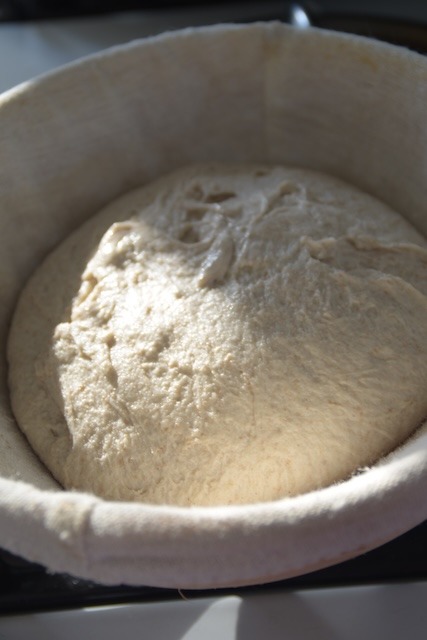
My basic (flexible) formula for sourdough loaves
As noted above, there are so many variables for baking sourdough bread. For instance, if you are baking with whole grains, the dough might require higher hydration.
But sourdough is also very forgiving provided you have a basic understanding of the different factors at play. For instance, if you are pouring flour from the bag and too much drops into the bowl, you might have to judge when to add more water and salt to compensate for the flour and when that extra flour does not matter too much to the final composition because it is still within an okay range.
| Ingredient | Baker’s percentage | Weight (grams) |
|---|---|---|
| Flour | 100% | 400 g |
| Water | 65-75% | 260-300 g |
| Starter | 10-15% | 40-60 g |
| Salt | 1.5-2% | 6-8 g |
I generally aim for a 75% hydration dough, which works well for everyday boules. Using this formula, the total hydration of the dough ranges from 70% on the low end to 82.5% on the high end. When the hydration level is on the higher side, it may be appropriate to incorporate add-ins that absorb water such as seeds and dried fruit.
I don’t use a set percentage for add-ins. My rule for add-ins is “a good handful” or “as much as can be folded in” for bulky things like nuts, dried fruits, or cheese, and a tablespoon or so for things like spices and herbs.
Notes on baking with different types of flour
- I generally use a mix of whole spelt or rye flour and strong white flour (bread flour). In a basic loaf I will use approximately 20-50% spelt flour.
- I do not recommend using above 50% whole grain flour if the loaf will have add-ins as it may not have enough structure.
- More spelt or rye flour yields a denser loaf with more flavour (sourness/sweetness). Note that a loaf with a high amount (e.g. more than 50%) of rye flour may require resting time to prevent gumminess when slicing. More bread flour gives better (bouncier) texture and lighter flavour.
- If you don’t have bread flour, all purpose is ok too, but the higher the gluten amount, the better.
Some of my favourite sourdough add-ins and flavour combos
- shredded cheese + chilli flakes ?
- dates + walnuts
- cranberries/raisins + nuts or seeds ?
- cocoa powder + chocolate chunks + hazelnuts ?
- a flavourful honey (e.g. buckwheat honey) ?
- herbs (rosemary, thyme, oregano etc!) ?
- spices (cumin, coriander, cinnamon etc!) ?️
- christmas: gingerbread spice + candied ginger, candied peel, dried fruits ?
- pumpkin spice + pumpkin puree ?
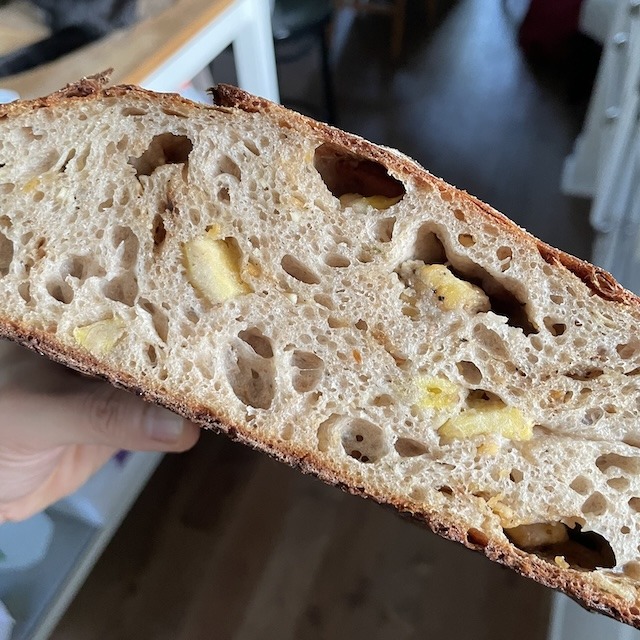
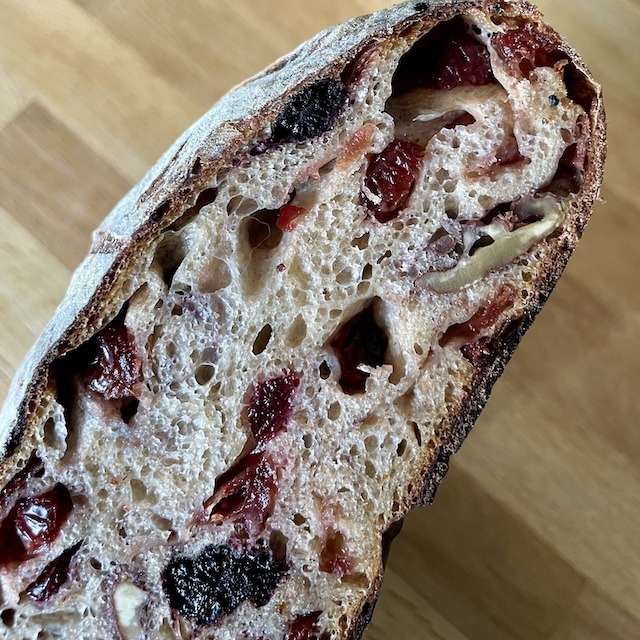
Wildcard sourdough add-ins that work really well!
I’ve added many random stuff into bread – whatever strikes my fancy, in it folds into the dough. Here are my favourite unexpectedly delicious add-ins. Try it and let me know what you think!
- aonori (green seaweed flakes). Trust me, so good!
- plantain chunks – better than bananas, the firm potato-like texture contrasts nicely with the bouncy bread.
Method – how to make sourdough and the concepts behind each step
Mixing and developing gluten structure
The easiest way to mix a dough is to mix everything (except add-ins) in a bowl with a dough whisk. Gluten is developed throughout fermentation and with a series of stretch and folds. (This is a primary difference between baking with sourdough as compared to commercial yeast, where often the dough has to be mixed to full gluten development in the initial mixing stage.)
For a stronger dough, some people prefer the autolyze method, where water and flour is mixed and allowed to rest for a period of time before the salt and starter is incorporated into the dough. The autolyze method provides stronger gluten structure, which may be useful if you know your flour is weak, or you will be adding in lots of mix-ins. I do not autolyze for everyday bread, because it is an extra step and adding the starter to the already elastic dough can be quite a messy process.
Depending on the strength of your flour and the hydration of the dough, you will want to perform between 2-5 stretch and folds (this is exactly what it sounds like, where you stretch the dough and fold it over itself in the bowl. Turn the bowl 90 degrees, then stretch and fold again.)
If you are adding in bulky add-ins (e.g. walnuts, dried fruits, cheese), you should add it after the first stretch and fold. Subsequent stretch and folds will help incorporate the add-ins evenly within the dough.
Timing and proofing sourdough
The joy about baking with sourdough is that it is very flexible and intuitive. It is essential to develop the skill of “reading the dough” instead of relying on set times. If unsure, err on the side of over-proofing rather than under-proofing.
Retarding the dough
This is a baking term! Retarding the dough helps develop flavor and also provides you with more control of when you want to bake. Lowering the proofing temperature slows down fermentation.
You want to have the dough bulk ferment for at least a couple of hours, but after that, you can chuck it in the fridge if you don’t have time to perform the next steps. I commonly retard the dough after bulk fermentation but before shaping, or after shaping and final proofing for a couple of hours. Sourdough can be retarded for as long as 4 days (in fact, multi-day cold proofing is common for pizza dough and is said to help develop “blisters”).
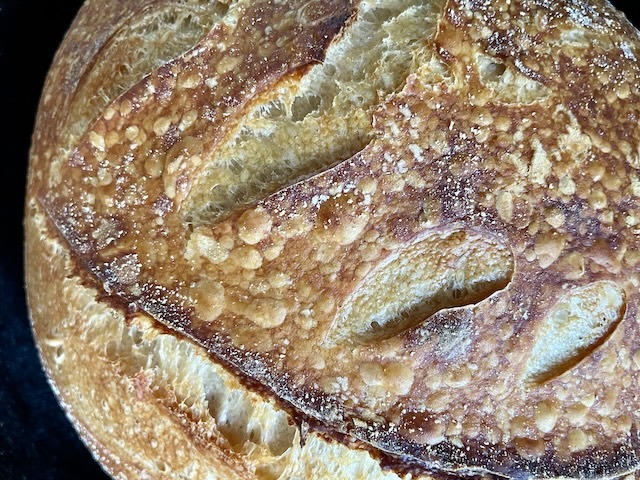
Shaping for boules
The usual way to shape a boule is to 1) pre-shape and 2) shape and tighten the dough. There are many videos on how to shape dough. The technique for boules and batards differ slightly but the concept is the same. Essentially you want to redistribute the dough and form it into the desired shape while tightening the outside “skin”. How you do this may depend on the hydration of the dough, how you want the scoring to look, and whether it is under-proofed or over-proofed.
A pre-shape may not always be necessary. The goal of pre-shaping is to divide the dough and to make shaping easier. If your recipe makes only one loaf (as is the case for most home bakers), pre-shaping can be skipped. I find that pre-shaping is especially unnecessary for round loaves such as boules, which are easy to form.
Shaping the dough is usually done on the countertop, sometimes with the help of a bench scraper. For boules, you want to form the dough into a ball by pulling the edges into the center. Turn the dough over so it is seam side down, and then tighten the ball by pulling the dough towards you or in a circular motion.
If you are shaping dough for a round boule or oval batard and would like to do it the laziest way possible, read on.
Lazy “no-countertop” shaping
Recently in the height of lazy inspiration I have been using a “no-countertop method” to shape the dough. Instead of cleaning the countertop and shaping the dough on said countertop, I shape the dough directly with my hands by stretching and folding. After bulk proofing is complete, I ready the banneton by dusting with rice powder (if needed). I take the dough from the bowl and perform a couple of stretch and folds or coils so that the dough is fairly tight and in a rough ball shape before plopping into the banneton. This method allows me to still get the dough into a tight ball shape with minimal clean up.
The result has been surprisingly good. My no-countertop method is by no means the ideal method for shaping dough. It is, however, the most low-effort method of shaping short of not shaping your dough at all. Again, it all depends on your intention for baking. Some people elevate their sourdough into an art form and aim for that perfect aeration and cross-section, other people bake for sustenance. I aim for that point where taste and ease meets, asking “how can I make the tastiest loaf of bread with the least effort possible?”
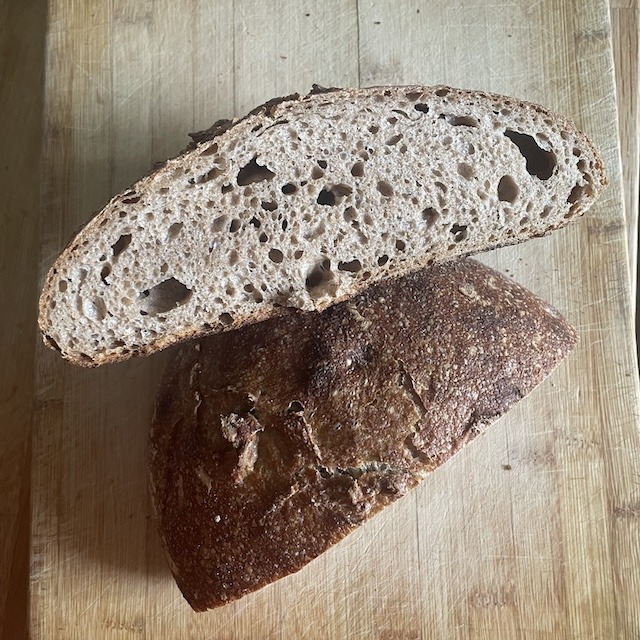
Scoring sourdough loaves
Once the dough has finished proofing and is ready to go into the oven, it is time to score. Scoring allows you to control how the dough expands in the oven.
There are many ways to score a loaf. Because I bake boules and I care more about the taste and texture than the appearance of the scoring – I lean towards simple, straight scoring such as in a cross pattern or in a single slash. The right depth and amount of scoring will depend on the degree of gluten development and proofing of the dough.
How to make sourdough without a banneton?
Many people who are just getting started with sourdough may not have a banneton proofing basket. Luckily, there are so many types of bread which do not require shaping and proofing in a banneton:
- buns
- bagels
- pan loaf
- focaccia
- pizza
If you insist on making a sourdough loaf, you can improvise a makeshift banneton by dusting a cheesecloth with rice flour and arranging it over a round shape of semi-permeable material, like a wicker basket or a large paper bowl.
Baking for a crusty loaf
The basic idea is to create a hot environment and to have enough steam in the first part of baking. A dutch oven completes both of these goals.
If you do not have a dutch oven you can try splashing some water (or ice cubes) in the oven when putting in the bread.
Conclusion
Bread baking can get incredibly nuanced. Not only are there many varieties of bread, even for the basic sourdough loaf, there are so many factors for trying to get that perfect loaf.
But we are not perfectionists here. We want to make a tasty but low effort loaf (think of it as being a B+ grade instead of A++). We want to understand how to simplify the bread making process as much as possible without losing too much quality. In other words, what is the minimum you can do and still end up with a respectable loaf of bread?
Questions? Concerns? Consternation? Let me know in the comments below.
Basic Sourdough Loaf
Equipment
- kitchen scale
- dutch oven
- banneton
Ingredients
- 400 g bread flour (or a mix of whole grain and bread flour)
- 280 g water
- 40 g starter, ripe and ready to use
- 7 g salt
- a handful of your desired add-ins (nuts, fruit, cheese etc – see post content for ideas)
Instructions
- Combine flour, water, starter, and salt in a bowl. With a dough whisk or your hands, mix until uniform.
- Let rest for 20-30 minutes, then give a series of stretch and folds.
- If using add-ins, add them to the dough now (i.e. after the first stretch and fold). Incorporate the add ins by stretching and folding the dough at 30 minute intervals for another 2 or 3 times. As you stretch and fold, the dough will become more elastic and smooth and strong and the add-ins more evenly incorporated,
- If not using add ins, you should perform a total of 2-4 stretch and folds at rough 30 minute intervals.
- Let dough rise for 4-8 hours (or overnight). The dough should have almost doubled.
- Prepare your banneton by dusting liberally with rice flour. If your banneton has a cotton covering, the rice flour should be rubbed into the cotton.
- Tip the dough onto the counter and form it into a round or oval shape (depending on your banneton). Transfer the dough seam side up into the banneton. If the seams open up, stitch them together by pulling the seams into the center and pinching slightly.
- Let the dough proof in the banneton until puffy. When you poke the dough, it should take a long time (30 s) to bounce back. Alternatively, you can let the dough cold-proof in the refrigeration for up to 2 days after shaping and placing in the banneton.
- Place your dutch oven inside your oven and preheat the oven to 450 F.
- Once heated, remove the dutch oven. Remove the top of the dutch oven. Tip the dough from the banneton over onto the bottom of the dutch oven. Score the dough with a bread lame or a sharp knife.
- Bake for 20 minutes, covered. Then bake uncovered for another 20 minutes, or until golden brown and the bottom of the bread makes a hollow sound when tapped.
- Let cool completely before slicing.
Subscribe to my newsletter
(Sporadic) updates on new posts and recipes sent straight to your inbox.
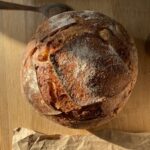
Leave a Reply